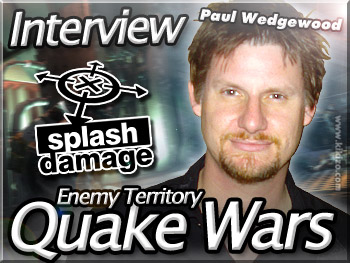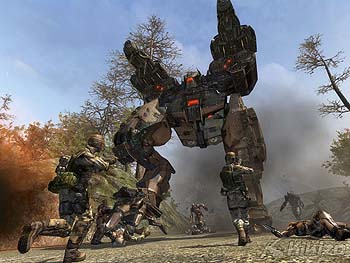Enemy Territory: Quake Wars Interview
Splash Damage's Paul Wedgewood takes us behind the lines of this team-based shooter.
Page: 1 2
Enemy Territory: Quake Wars wasn't originally planned for any platform other than PC but at some point developer Splash Damage got the Xbox 360 controller talking to the PC, noted how accessible the game had been designed, and thought, Why not?

"About two years in we got the analog controller working on the PC and we just thought, 'Cool, this is fun. Why don't we do this for the console?' It was as modest a reason as that for wanting to port it to the 360 and the PS3," explains Paul Wedgewood, the owner of Splash Damage and lead designer on Enemy Territory: Quake Wars.
One of features most important to bringing the game over to the Xbox 360 (being developed by Nerve) and the PlayStation 3 (Z-Axis) is the modest Use key - a contextual button PC and console players can use to take care of many of the actions open to them on the battlefield. And when the action is as fast-paced as this, simplicity can be good.
Enemy Territory is a prequel to Quake II that tells the story of the initial invasion of the Strogg in 2065. You'll be able to play on either side of the invasion, taking part in small- to large-scale battles.
Gameplay is centred around teamwork, and everything from the character classes to the maps and the rewards earned through skillful play have been designed around making this a game that you'll want to play with others.
"Your teammates, whether they're bots or whether they're human players, find it much easier to coordinate with you, and I think that's the thing that's dramatically different about Enemy Territory: Quake Wars," says Wedgewood.
Communication is essential because there's a lot going on on the battlefield. You'll be able to pick from around a dozen character classes, each of which will be dynamically assigned missions by other players during battles.
Say you're playing as an engineer, one of the Global Defence Force support classes responsible for deploying various offensive and defensive turrets and for rearming men in the field. If one of your GDF teammates needs ammunition, he can set a mission through an easily reachable contextual interface, calling for an engineer to come over to him. That's where you come in. You'll then have to complete the mission by going over to your compatriot to refuel his weapons.
The game is built around teamwork like this and actively discourages the sort of obnoxious play that infests so many shooters. For instance, players will get no experience points for blowing up vehicles that are sitting idle at an enemy base and camping at character spawn sites won't help either. At all times players are encouraged to work together to achieve their goals.
The post-game stats are a good example of the results of your work. The usual statistics are supplemented by others that list the best player on the team in each character class. This approach is echoed in the way your performance is tracked in game. For instance, if you're playing as a covert operations characters, you'll get more rewards for sneaking into bases to set traps and gather intelligence than you would for simply sniping people from afar. "We don't just reward people who play as individuals," says Wedgewood.
Page: 1 2









 Satoru Iwata Video Interview - the late Nintendo president spoke with Kikizo in 2004 as 'Nintendo Revolution' loomed.
Satoru Iwata Video Interview - the late Nintendo president spoke with Kikizo in 2004 as 'Nintendo Revolution' loomed. Kaz Hirai Video Interview - the first of Kikizo's interviews with the man who went on to become global head of Sony.
Kaz Hirai Video Interview - the first of Kikizo's interviews with the man who went on to become global head of Sony. Ed Fries Video Interview - one of Xbox's founders discusses an epic journey from Excel to Xbox.
Ed Fries Video Interview - one of Xbox's founders discusses an epic journey from Excel to Xbox. Yu Suzuki, the Kikizo Interview - we spend time with one of gaming's most revered creators.
Yu Suzuki, the Kikizo Interview - we spend time with one of gaming's most revered creators. Tetris - The Making of an Icon: Alexey Pajitnov and Henk Rogers reveal the fascinating story behind Tetris
Tetris - The Making of an Icon: Alexey Pajitnov and Henk Rogers reveal the fascinating story behind Tetris Rare founders, Chris and Tim Stamper - their only interview? Genuinely 'rare' sit down with founders of the legendary studio.
Rare founders, Chris and Tim Stamper - their only interview? Genuinely 'rare' sit down with founders of the legendary studio. The History of First-Person Shooters - a retrospective, from Maze War to Modern Warfare
The History of First-Person Shooters - a retrospective, from Maze War to Modern Warfare